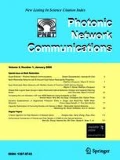Abstract
Jitter and BER performance of non-linear clock recovery circuits are evaluated for a minimum bandwidth signal. To investigate the effect of bandwidth in optical transmission, BER performance of MB810 and NRZ signals with various types of timing recovery circuits are compared for a 40 Gbit/s optical link. Among the systems adopting non-linear timing recovery circuits, the MB810 signal employing an absolute value rectifier shows superior performance. We show that timing recovery without a non-linear circuit is also possible, and compare its BER performance with that of the others. Jitter performance of the fourth-law rectifier and that of the absolute-value rectifier is made for a minimum bandwidth signal. The mathematical derivation of the timing wave is also carried out for the clock recovery of the fourth-law rectifier. The result shows that the derived timing wave is expressed as a function of a pulse shape entering the timing path and the band-pass filter tuned to the pulse repetition rate.
Similar content being viewed by others
References
A. J. Price, N. Le Mercier, Reduced bandwidth optical digital intensity modulation with improved chromatic dispersion tolerance, IEE Electronics Letters, vol. 31,no. 1, (Jan. 1995), pp. 58-59.
S. Kuwano, K. Yonenaga, K. Iwashita, 10Gbit/s repeaterless transmission experiment of optical duobinary modulated signal, IEE Electronics Letters, vol. 31,no. 16, (Aug. 1995), pp. 1359-1361.
T. Frank, T. N. Nielsen, A. Stentz, Experimental verification of SBS suppression by duobinary modulation, in: Proc. ECOC'97, (Edinburgh, UK, Sept. 1997), vol. 1, pp. 71-74.
C. G. Lee, A new line code for 10-Gigabit ethernet:MB810, Proc. ICC2000, (New Orleans, Louisiana, USA, June 2000), pp. 1774-1777.
D. Y. Kim, J. I. Back, J.-K. Kim, S. K. Hyun, Y. K. Park, Run-length-limited variants of duobinary and modified duobinary, IEEE Trans. Commun., vol. COM-35,no. 2, (Feb. 1987), pp. 142-150.
D. Y. Kim, J.-K., Kim, A condition for stable minimum-bandwidth line codes, IEEE Trans. Commun., vol. COM-33,no. 2, (Feb. 1985), pp. 152-157.
J. E. Mazo, Jitter comparisons of tones generated by squaring and by fourth-power circuit, Bell. Syst. Tech. J., vol. 57,no. 5, (May–June 1978), pp. 1489-1498.
L. E. Franks, J. P. Bubrouski, Statistical properties of timing jitter in a PAM timing recovery scheme, IEEE Trans. Commun., vol. COM-22,no. 7, (July 1974), pp. 913-920.
N. A. D'andra, U. Mengari, A simulation study of clock recovery in QPSK and 9QPSR system, IEEE Trans. Commun., vol. COM-33,no. 10, (Oct. 1985), pp. 1139-1142.
Thomas T. Fang, Analysis of self-noise in fourth-power clock regenerator, IEEE Trans. Commun., vol. 39,no. 1, (Jan. 1991), pp. 133-140.
L. E. Franks, Signal Theory, (Prentice-Hall, Englewood Cliffs, NJ, 1969).
W. R. Bennet, Statistics of regenerative digital transmission, Bell. Syst. Tech. J., vol. 37,no. 6, (Nov. 1958), pp. 1501-1542.
H. Nyquist, Certain topics in telegraph transmission theory, Trans. AIEE, vol. 47, (Apr. 1928), pp. 617-644.
Author information
Authors and Affiliations
Corresponding author
Rights and permissions
About this article
Cite this article
Chun, K.G., Kim, D.Y. A Simulation Study on Clock Recovery of a Minimum Bandwidth Signal. Photonic Network Communications 6, 83–89 (2003). https://doi.org/10.1023/A:1023642926131
Issue Date:
DOI: https://doi.org/10.1023/A:1023642926131




